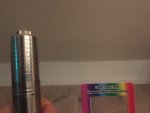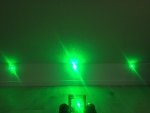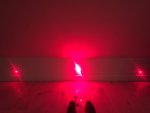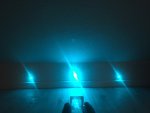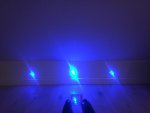- Joined
- Sep 12, 2007
- Messages
- 9,399
- Points
- 113
It has been insisted to me by one person in particular that a 1000 line/mm grating will produce 6 beams. The math says a 1000 line/mm grating will produce 3 beams above 500nm, and 5 beams below 500nm. My testing agrees. I provided photographic evidence of a green laser producing 3 beams, but I was called a liar and told I was doctoring and misrepresenting photographs. I don't like being called a liar. So I'm taking the scientific approach: peer-review.
Note, the second order (fourth and fifth beams) may be very dim and off at a wide angle on the blues/violets. But they should be there according to the math.
I'll give 4 free gratings each to the first 6 people. Here's how this will work:
1) You must have 100 posts or more (for integrity reasons) and be in the US (for shipping reasons).
2) post in this thread to claim a spot.
3) once 6 people have been selected and confirmed, each will purchase https://www.ebay.com/itm/292403982201
4) PM me a screenshot of the receipt (with personal info blacked out as you see fit) and a PP address.
5) I will deposit $6 as reimbursement.
6) when your gratings arrive, perform tests with various colors and post your results and photographs here. If it is indeed 6 beams and not 3 (or sometimes 5), I want to know, because you may be entitled to a Nobel prize in physics for such a discovery.
7*) if you already have a 1000 line/mm grating and would like to participate, please do!Hell, I'll throw in $3 to the PP of your choice for your trouble if you want. (This part of the offer retracted since the matter appears to be settled)
Edit: List of confirmed claimants (1/6):
RA_pierce
Other:
$3 was donated to the forum on jnrpop's behalf on 9/24
Note, the second order (fourth and fifth beams) may be very dim and off at a wide angle on the blues/violets. But they should be there according to the math.
I'll give 4 free gratings each to the first 6 people. Here's how this will work:
1) You must have 100 posts or more (for integrity reasons) and be in the US (for shipping reasons).
2) post in this thread to claim a spot.
3) once 6 people have been selected and confirmed, each will purchase https://www.ebay.com/itm/292403982201
4) PM me a screenshot of the receipt (with personal info blacked out as you see fit) and a PP address.
5) I will deposit $6 as reimbursement.
6) when your gratings arrive, perform tests with various colors and post your results and photographs here. If it is indeed 6 beams and not 3 (or sometimes 5), I want to know, because you may be entitled to a Nobel prize in physics for such a discovery.
7*) if you already have a 1000 line/mm grating and would like to participate, please do!
Edit: List of confirmed claimants (1/6):
RA_pierce
Other:
$3 was donated to the forum on jnrpop's behalf on 9/24
Last edited:




